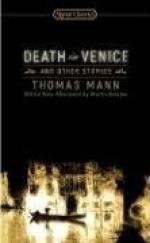|
This section contains 5,307 words (approx. 18 pages at 300 words per page) |

|
SOURCE: Giobbi, Giuliana. “Gabriele D'Annunzio and Thomas Mann: Venice, Art, and Death.” Journal of European Studies 19, no. 1 (March 1989): 55-68.
In the following essay, Giobbi finds parallels between Death in Venice and Gabriele D'Annunzio's Il Fuoco.
The Venice of modern fiction and drama is a thing of yesterday, a mere efflorescence of decay, a stage dream which the first ray of daylight must dissipate into dust.1
Because of its unique nature and atmosphere, Venice has traditionally been a favourite setting in the fiction and poetry of European authors. The architecture of Venetian buildings attracted the attention of Art critics like John Ruskin, and the wealth of masterpieces contained in Venice's churches and museums were required study for scholars as well as the object of admiration for foreign tourists. But Venice was not only a city of Art; it was also a city of sickness, decay, death.2 For its very...
|
This section contains 5,307 words (approx. 18 pages at 300 words per page) |

|


